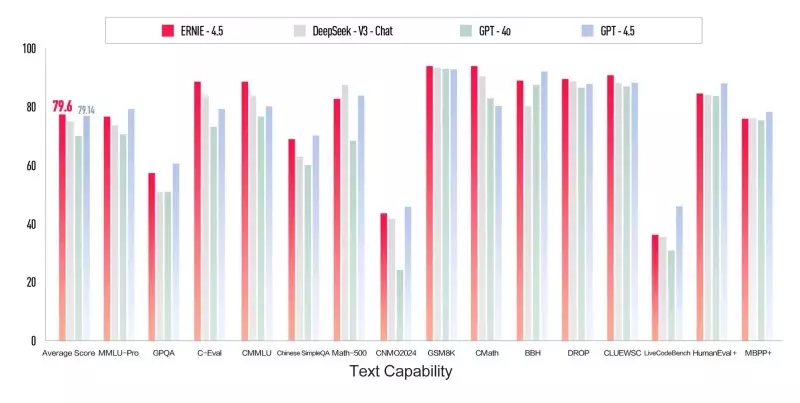Over the weekend, Baidu, a frontrunner in Chinese technology, unveiled two groundbreaking AI models: ERNIE 4.5 and ERNIE X1. As industries globally pivot towards integrating artificial intelligence, Baidu is keen to capture attention with its competitive offerings that claim to outperform established names like OpenAI and DeepSeek. This ambitious launch not only represents a leap in technical capabilities but also a strategic maneuver in the AI ecosystem, particularly as companies incorporate AI solutions into their business models.
This unveiling is significant in a market rife with competition, especially in the realm of language models and complex reasoning systems. Both ERNIE 4.5 and ERNIE X1 are designed to challenge and potentially surpass existing leaders in the field, showcasing Baidu’s commitment to innovation and performance excellence.
Performance Metrics: A Detailed Analysis
Baidu boasts that its models deliver state-of-the-art performance across a variety of benchmarks. The ERNIE 4.5 model, designed as a multimodal framework, can process not only text but also images, audio, and video. This capability positions it as a direct challenger to OpenAI’s GPT-4.5. With reported superiority in metrics from assessments like C-Eval, CMMLU, and GSM8K, Baidu claims its models not only outperform but also do so at dramatically reduced operational costs—citing price cuts of up to 99% compared to counterparts like OpenAI.
However, behind these figures lies a complex web of context limitations. The sheer volume of tokens that a model can handle for processing and analysis is critical in determining its effectiveness. ERNIE 4.5, with a restrictive 8,000-token context window, is minuscule compared to the 128,000-token capacity of GPT-4.5. This constraint, as one user pointed out, might reduce the practicality of ERNIE 4.5 for applications beyond basic customer service automation. It’s a fascinating juxtaposition: while ERNIE models are set to revolutionize AI on one front, they may fall short for more elaborate use cases due to inherent limitations.
Cost-Effectiveness: A Double-Edged Sword
Another major focal point of Baidu’s strategy is price. The company has positioned its models as cost-effective solutions, dramatically undercutting competitors. With input and output costs set at remarkably lower rates, ERNIE 4.5 and X1 present organizations with a tempting proposition—one that might lead to significant budget savings when integrating AI into workflows. Nevertheless, the allure of lower costs should come with a careful assessment of performance across various applications.
Companies exploring these new models must weigh potential savings against practical effectiveness. While the apparent affordability is enticing, it should not overshadow the critical need for real-world testing to validate the claims made by Baidu. There exists a fundamental risk that prioritizing cost might lead businesses to overlook potential challenges posed by limited model capabilities.
Innovative Features and Unique Selling Points
Both ERNIE models come equipped with advanced functionalities that promise to reshape the approach to AI tasks. ERNIE 4.5 boasts technologies such as FlashMask Dynamic Attention Masking and Self-feedback Enhanced Post-Training, aiming to refine its reasoning, comprehension, and generation abilities. Meanwhile, ERNIE X1 is particularly geared towards sophisticated reasoning tasks, integrating complex tool interactions that could significantly enhance productivity in enterprise settings.
The models also focus on multilingual support, specifically tailored to understanding Chinese language nuances—an essential feature for companies engaged in the Chinese market or targeting Chinese speakers worldwide. This localized approach might present enhanced relevance compared to more generalized global models, potentially allowing Baidu to secure a niche in an otherwise crowded landscape.
Strategic Considerations for Enterprises
As Baidu continues to develop and integrate its AI offerings into its ecosystem—such as Baidu Search—business leaders must grapple with strategic decisions regarding adoption. CIOs and CTOs should consider not only the immediate benefits of implementing these technologies but also the long-term implications related to data privacy, compliance, and the ethical use of AI. The forthcoming open-source release of ERNIE 4.5 raises crucial questions about data management practices that organizations will need to navigate carefully.
Furthermore, enterprises should prepare for a future where AI capabilities are continuously evolving. Baidu’s ongoing investment in AI and cloud computing indicates that these models will only improve over time, pressuring organizations to stay updated to remain competitive. The interface for these models allows for smooth integration, yet decision-makers must ensure their teams are equipped to maximize the potential of these tools effectively.
In this rapidly advancing world of artificial intelligence, Baidu aims not just to keep pace with global innovations but to lead in providing resourceful and affordable solutions. The launch of ERNIE 4.5 and X1 signifies a critical moment in technological evolution, and the implications for both users and competitors are profound.

